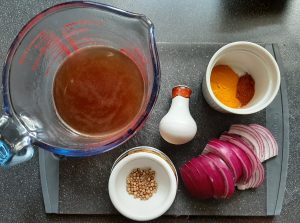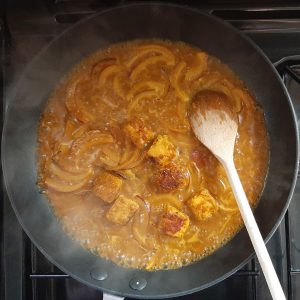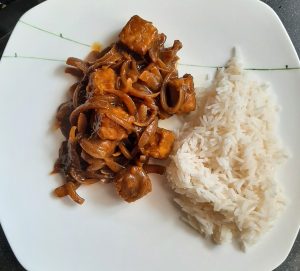August 26, 2021, by Kathryn Steenson
Keep calm and Curry on
 This year’s theme for Heritage Open Day (10-19 September) is Edible England, a subject that I can genuinely get excited about. There are quite a few recipe books and household management guides in the collections, ranging from handwritten books of favourite recipes, to published volumes that went through multiple editions and included advice on cooking for banquets and feasts.
This year’s theme for Heritage Open Day (10-19 September) is Edible England, a subject that I can genuinely get excited about. There are quite a few recipe books and household management guides in the collections, ranging from handwritten books of favourite recipes, to published volumes that went through multiple editions and included advice on cooking for banquets and feasts.
Several staff have tried out recipes, usually for cakes and biscuits, and as normally we host HoD events in person, we initially thought we might offer a selection as refreshments, but given the uncertainties over the Covid situation, we decided to offer a virtual event this year. Although this meant I couldn’t inflict some of the recipes on the public, it gave me the opportunity to try out a few that we wouldn’t be able to bring in, like this chicken curry recipe.
This recipe for ‘India Curry’ with boiled rice was published in 1786 in The New Lady’s Magazine (as well as food, it had articles on fashion and gossip, which shows that women’s magazines haven’t changed much in 250 years):
Take a quart of good beef gravy, have ready some turmeric in powder, and likewise some coriander seed beaten very fine. Put in the gravy a tablespoon of the turmeric and two teaspoons of the coriander seed, a teaspoon of cayenne pepper and salt to your palette. Take two fowls or large chickens, cut them into joints, skin them, and fry them in butter till brown, with a few onions cut fine and fried with them. Then pour in your gravy and let it stew altogether half an hour: if you have three pints or two quarts of gravy it will be better. Serve it up in a terrine or soup dish, and boiled rice in a small dish by itself.
I won’t include the recipe for boiled rice, since it is basically boil rice.
First things first: the quantities. I don’t know how many this was supposed to feed, because it doesn’t say (eight people, perhaps?), but two chickens is too many chickens for one person. Also, having been vegetarian for many years, I swapped the chicken for my preferred brand of vegetarian meat substitute pieces, reasoning that it wouldn’t matter because the purpose of this exercise was to see what the curry sauce tasted like.
The quantities of the spices were quartered. This is still far more spice per person than the recipe intended, but this was more practical as my smallest measuring spoon is 1/4 teaspoon. For the beef gravy I used a well-known brand of beef flavour gravy granules (they are vegetarian!). A quart is roughly 1.1 litres, so I used 250ml of gravy. A the end of the recipe it recommends doubling this, but if a household was making gravy using cooking juices from their roast beef, three pints would have been a huge quantity to have leftover. It seemed more realistic to use the smaller amount.
After frying the protein and half a sliced red onion in butter for a few minutes, I poured in the gravy. Half an hour seemed a little excessive, as I was cooking much smaller pieces than chicken joints. After 15 minutes on a medium heat, everything looked cooked and the liquid had reduced to the point that serving it in a soup dish really wasn’t necessary. For those who like their curry sauces runnier, definitely add more gravy!
The result? It actually tasted pretty good. It’s not going into my regular rotation of meals, but it could be one of those stand-by recipes if I wanted something quick and easy using ingredients already in the cupboards. It was probably a medium level of heat, but this meal contained around double the amount of spice per person as originally intended. It would have been quite a mild dish, and not at all representative of authentic Indian cooking, but it’s spicier than I’d expected from a 1786 recipe. Curry was still relatively new to Britain, and the clue to that is in the quantities of spices. Most recipes form this period don’t give precise measurements, especially not for things like herbs which were added to taste, but here they have listed quantities of spices to the teaspoon.
If you’re interested in culinary history, then our Heritage Open Day talk ‘Health, Wealth and Tastiness‘ will be available online from the 10 September, along with links to our other blog posts reviewing recipes. To see the New Lady’s Magazine or any of the other food-related documents in the collections, email us to book an appointment in the Reading Room.




Nice post. amazing recipe looks delicious Thank you and keep up the good work.